- Home
- Deborah Blum
The Ghost Hunters Page 6
The Ghost Hunters Read online
Page 6
Myers, on the other hand, agreed with Sidgwick without hesitation—so readily that it caught the professor by surprise. He had known Myers largely as one of his brighter students—a tall, gray-eyed young man with carefully elegant clothes and smoothly waved brown hair. Sidgwick was pleased to find behind the stylish exterior a classics scholar with the heart of a crusader.
It was natural that their conversation should drift to Sidgwick’s other unpopular cause. In his spare time, Sidgwick continued to investigate for the Ghost Society, sifting for evidence of spirit communication. Myers was fascinated by what occurred in those darkened rooms; in their faint hints of a life after death, he saw a way to try to resolve the questions and doubts that had been so far intractable. In those early supernatural investigations, Myers saw the shape of a bigger quest, “an endeavor to learn the actual truth as to the destiny of man.”
Years later, describing his part in building an organization dedicated to psychical research, Myers put his role in self-deprecating perspective. He was the dreamer of the group: “Edmund Gurney worked at the task with more conscientious energy; the Sidgwicks [Henry and, later, his wife, Nora] with more unselfish wisdom; but no one more unreservedly than myself... staked his all upon that distant and growing hope.”
FOLLOWING HIS SPIRITUAL insights, Alfred Russel Wallace in the late 1860s invited a series of respected scientists—including a noted physiologist and rather brilliant physicist named John Tyndall—to attend private séances at his home and investigate the phenomena. As he explained to another invitee, T. H. Huxley, Wallace hoped that his colleagues would consider such study “a new branch of Anthropology.”
As might be expected, Huxley’s response was more barbed than the other rejections. Huxley had been to a few seances earlier in his life, and he’d found them ridiculous. Wallace might be onto something, but Huxley wasn’t impressed by whatever it was: “It may all be true, for anything I know to the contrary,” he wrote in reply to the invitation, “but really I cannot get up any interest in the subject.”
Undaunted, Wallace pressed him again; many of the scientists had flatly refused, and Tyndall had stayed but a few minutes before stomping out the door. Wallace knew Huxley from their mutual labors in favor of natural selection; he hoped that collegiality would persuade him. Huxley’s second refusal was more pointed. As he explained, he’d heard enough of spirit communications to know that they were so much nonsense. He didn’t need to bore himself senseless by sitting through a seance in person: “The only good argument I can see in a demonstration of the truth of ‘Spiritualism’ is to furnish an additional argument against suicide. Better to live a crossing-sweeper than die and be made to talk twaddle by a medium hired at a guinea a séance.”
Finally, Wallace accepted that his circle of acquaintances seemed more likely to ignore his new science than advance it. He decided to give his ideas a more public airing, and in April 1869 published a paper laying out his view that natural selection might have limits, that an “overruling intelligence” might be responsible for the development of mental and moral behavior.
Wallace undoubtedly felt driven to be combative. He complained that a scientist seeking to explore the supernatural found himself instantly demoted, “set down as credulous and superstitious, if not openly accused of falsehood and imposture, and his careful and oft-repeated experiments ignored as not worth a moment’s consideration.” But it wasn’t just exasperation that prompted Wallace to air his argument. It was his sense of rightness, his conviction that understanding supernatural events could help illuminate “the nature of life and intellect, on which physical science throws a very feeble and uncertain light.” Wallace believed, he said, that all branches of science would suffer until such inexplicable happenings were seriously investigated and “dealt with as constituting an essential portion of the phenomena of human nature.”
His colleague’s righteous tone further alarmed Darwin. After reading an early version of the manuscript, he wrote to Wallace, “If you had not told me, I should have thought they [the comments] had been written by somebody else. As you expected, I differ grievously from you and I am very sorry for it.”
But Wallace wasn’t sorry. He had failed to win over Darwin or his illustrious group of allies, but he was moving on to better prospects. At long last, Wallace had persuaded another of Britain’s more acclaimed scientists—the chemist and inventor William Crookes—to conduct a serious investigation of the ever-elusive D. D. Home.
WILLIAM CROOKES was a thirty-nine-year-old Londoner, a big man with narrow blue eyes in a narrow, high-cheekboned face, a dark beard, and a splendidly imperious manner. A designer of scientific equipment and a gifted chemist, Crookes had recently discovered a new element, which he named thallium. A soft, malleable metal, thallium was also a neurotoxin so potent that later generations of scientists would speculate that Crookes became involved in spirit research only because of work-related brain damage.
As Crookes told it, though, he hadn’t found Wallace’s arguments particularly convincing. He thought he might be able to help straighten out the errant naturalist. Crookes’s initial plan was to scrutinize a few so-called mediums and finish the subject off.
One of the first mediums that Crookes visited was a thin, intense, small woman who held sittings in her neat little parlor. She seemed simple enough in technique, using one of the more popular devices of the time for spirit communication, a planchette.
A planchette was a heart-shaped piece of wood, mounted on small wheels so that it rolled. At its narrow end it held a pencil, point down so that it just brushed a piece of paper placed underneath. To operate a planchette, users put a hand on the wood, concentrated, and allowed “spirit energy” to flow through their fingers. As the planchette rolled, the pencil scrawled its way across the paper, sometimes tracing meaningless scribbles and sometimes what appeared to be written messages.
The medium, Crookes observed, shut her eyes, placed her fingers on a planchette, and waited for it to slide. As the chemist told the story, he was prepared to be entertained.
Could this invisible spirit, Crookes asked, see everything in the room, including things the psychic could not?
“Yes,” wrote the planchette.
Crookes stepped backward. He had noticed the Times tossed upon a small occasional table.
“Can you see to read this newspaper?”
“Yes,” was the reply of the planchette.
“ ‘Well,’ said I, ‘if you can see that, write the word which is now covered by my finger and I will believe you.”’
Standing with his back to the newspaper, he reached behind him, and pressed the tip of his right forefinger down on the newsprint.
The planchette hesitated unden the woman’s fingers.
“Slowly and with great difficulty the word ‘however’ was written. I turned round and saw that the word ‘however’ was covered by the tip of my finger.”
Crookes wasn’t the kind of man to be coy about his findings. In the winter of 1871 he published his planchette story—and his conclusion that it suggested some inexplicable power—in the Quarterly Journal of Science, a publication at which he served as editor. A few months later, Crookes published a more detailed and even more provocative report, the results of a series of tests he’d conducted on Daniel Dunglas Home.
The elegant Home still maintained his position as the professional medium most annoying to the scientific community. He’d risen above set-backs and controversies: Browning’s vitriolic portrait of him as Mr. Sludge, a very public lawsuit by a patron who wanted her money back, accusations that he was merely a talented magician, a proposal by an anthropologist that Home was actually a werewolf “with the power of acting on the minds of sensitive spectators.” The publicity always seemed to turn to his favor. His reputation flourished. In 1869, a trio of witnesses reported that Home had levitated off the floor of a second-floor room in a downtown London home, floated out from a window into the night, and drifted back in through the window o
f another room, his shadow flickering on the walls before his body slipped through the opening.
Home’s numerous critics had several years earlier asked Michael Faraday to debunk the great medium, as Faraday had debunked talking tables. The irascible physicist had agreed, but demanded that Home first sign a statement saying that even if Faraday found that his results were “miracles or the work of spirits,” the medium would admit that everything beyond those experiments was still “contemptible and worthless to mankind.”
Home’s supporters had shut down all further discussion with Faraday, and ever since, the famed medium had avoided the mainstream British science establishment. But at Wallace’s urging, Home agreed to allow Crookes to set up some tests in the chemist’s home laboratory and agreed that he would have no chance to inspect the laboratory in advance.
For one test, Crookes stretched a piece of parchment across a wooden hoop, attaching the hoop to a device that would etch any movement into smoked glass. He positioned Home near the experimental drum, not touching it but close. Crookes then took one of the medium’s hands and held it a careful ten inches above the parchment. A friend of Crookes held Home’s other hand at a similar level. The surface began to jiggle, pulling down, springing up. It looked as if an invisible hand was pushing at the surface of the parchment, lightly beating the drum, etching an uneven record into that glass plate.
In a similar test, Home was asked to stand by a mahogany board, set horizontally, but not to touch it. One end of the board rested on a pivot. The other was suspended from a spring balance. To guard against cheating, Crookes asked volunteers to hold the medium’s hands and feet.
“Can you make it move?” Crookes then asked.
He’d attached a measuring instrument to the board, so that each movement would be again scratched onto a smoked glass plate. Home stood silent, Crookes reported, just stood there, hands and feet held tight, while the board rose and fell and the needle scratched a jagged line, peak after valley after peak, across the darkened glass.
As a result of those and other experiments, Crookes reached a conclusion shocking to his fellow scientists: that some kind of as yet unexplained “psychic force” existed, and that “of all persons endowed with a powerful development of this Psychic Force, Mr. Daniel Dunglas Home is the most remarkable.”
In the next issue of London’s Quarterly Review, a journal known for its dedication to the political status quo, came the response from the leaders of British science.
The article was unsigned, but its author claimed to know Crookes well as a scientist of “purely technical” ability but with a sad lack of real intellect. The writer then added, with finely honed innuendo: “We speak advisedly when we say that the Fellowship of the Royal Society was conferred upon him with considerable hesitation.” Innuendo rather than truth; in reality Crookes, after he discovered thallium, had been elected as a fellow of the Royal Society by unanimous vote and, it had been noted at the time, without debate.
Like Wallace before him, Crookes was naive about how his colleagues might see his paranormal investigations. He’d expected demands for replication, perhaps competition from those who wanted to conduct their own studies of Home. He had anticipated criticism of the equipment he’d used, suggestions for better tests. He’d not expected to be slandered by anonymous report—or to see his friends slandered with him. Crookes had received help from an electrician named Cromwell Varley in designing and building the equipment used to test Home. The forty-two-year-old Varley worked as a consultant to the Atlantic Telegraph Company and had just finished working on the 1869 installation of the first trans-Atlantic cable, a feat that made telegraph communication possible between Europe and North America.
The anonymous article in the Quarterly Review (widely known to be authored by a physiologist and friend of Huxley’s) also warned readers of “grave doubts” concerning Varley’s ability, serious enough to prevent the electrician from being admitted to the Royal Society. At the time of publication, however, Varley had been a member of the society for three months.
Enraged, Crookes stormed down to the journal offices, demanded a retraction, and demanded that the author be publicly identified. The editor of the journal refused, explaining that it wouldn’t be fair to the reputation of the writer, although as Crookes couldn’t help but notice, the Review seemed unconcerned with his own reputation.
The message seemed clear enough. Investigating supernatural events was off limits to scientists, unless the findings proved fraud. Those who chose to ignore that rule—unspoken but strictly enforced—would find themselves off limits as well.
IT WAS A December evening in 1871. Myers and Sidgwick were shivering their way across the Cambridge campus. The air was as clear and chill as ice water. They walked under a sky netted with stars, those tiny silver points of light, so distant, so unreachable.
Myers felt that they glittered with mockery. He had moved no closer to understanding the secrets held so closely in the reaches of space. He had not resolved his doubts about life and death, achieved no means, it seemed, of finding answers. He had continued to delve into theological writings. Both he and Sidgwick had read Crookes’s articles and the response to them. As far as Myers could see, traditional science and religion seemed interested only in proving themselves, not in resolving confusion, much less the questions of a lone British classics scholar. He felt completely on his own.
As he wrote years later, he kept looking back at those starry bits of light in the dark, looking up, looking out, and seeing not just the stars but a vastness that, in that moment, spoke of all that he wondered about the limits of physical reality. If there was an existence beyond the obvious, the mortal, shouldn’t somebody be seriously, systematically trying to learn more about it? Shouldn’t he be that somebody—he and Sidgwick, and perhaps a few others, like their mutual friend and fellow Cambridge scholar Edmund Gurney? The risks that such an effort would carry were apparent. One had only to observe the reaction to William Crookes’s experiments to see how career-damaging an exploration into the unexplained might be.
Yet despite these misgivings, Myers turned to Sidgwick and asked whether the older man thought it was possible that by investigating “observable phenomena”—ghosts, spirits, whatever they might find—some valid knowledge could be uncovered.
Sidgwick, swathed in his dark coat and long scarf, was watching the stars, too. They seemed steady out there, timeless. He’d been thinking about what Crookes had done, thinking about the implications. As they stood wrapped in darkness, he made a decision. Yes, he told Myers, he did think a serious study of spirits might offer “some last grounds of hope” in reaching beyond the material earth and into unexplored worlds beyond.
Both men knew that whatever study was going to be done, the mainstream research community was neither willing nor prepared to take on this subject. So they would do it themselves.
Myers exhaled. He wasn’t sure if it was the sound of relief or anxiety. He wasn’t in the least sure what they would find. But he knew they were committed to looking. Sidgwick, once decided, was a man who always followed through. Myers hoped to measure up. “From that night onward,” Myers wrote, “I resolved to pursue this quest, if it might be, at his side.”
He was optimistic about their chances of success. But then, as he’ admitted to himself, he had always been the dreamer in the group.
3
LIGHTS AND SHADOWS
FUELED BY AN angry sense of purpose, William Crookes deliberately expanded his work in the supernatural realm. He methodically catalogued the phenomena he’d now observed: raps, levitations of people and objects, lights and luminous hands, and the very rare appearance of phantoms. According to Crookes’s journal, he’d seen the latter only with D. D. Home, who could sometimes apparently persuade the shadows themselves to coalesce into human shapes.
Crookes emphasized that sittings with Home were rarely consistent. Over a period of hours, the medium alternated between producing startling effects and pro
ducing nothing at all. Crookes hypothesized that a greater power generated the good results, the “psychic force” that he had earlier proposed as the source of the medium’s abilities. He thought Home possessed only erratic control over this force. Crookes’s notion was that, as a talented psychic, Home either created or tapped into that unusual energy, which depleted itself, recharged, and was again exhausted during the sittings. As he made clear in his 1874 paper, Crookes valued the medium not as a performer but as a means of demonstrating that an occult force existed and might be measured.
In his more mainstream, scientific pursuits, Crookes was also fascinated by sources of energy invisible to the human eye. Even as he conducted his studies with D. D. Home, Crookes worked to refine the design of a piece of laboratory equipment used to observe a still mysterious kind of radiation. This device—which would come to be known as a “Crookes tube”—consisted of a sealed glass bottle, with almost all air removed, and with two electrodes set inside. When a high-voltage electric current passed between the electrodes, the tiny amount of air in the tube would begin to glow. If Crookes then removed all the air, creating a vacuum, a patch of fluorescence would appear on the wall of the tube. Because the light patch was aligned with the negatively charged electrode (called a cathode), the mysterious stream of luminous energy was named a cathode ray. Crookes continued to experiment with this strange radiation, eventually proving that the “rays” traveled in a straight line and could be blocked by objects in their path. Cathode rays themselves remained mysterious for more than a decade until the physicist J. J. Thomson—also using the controlled environment of a Crookes tube—deduced that the rays were streams of highly charged particles that Thomson called electrons.

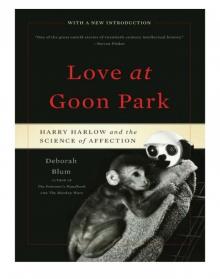 Love at Goon Park: Harry Harlow and the Science of Affection
Love at Goon Park: Harry Harlow and the Science of Affection The Poison Squad
The Poison Squad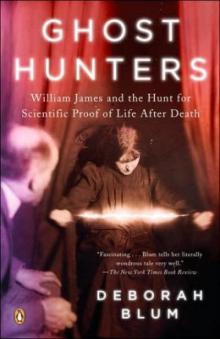 Ghost Hunters: The Victorians and the Hunt for Proof of Life After Death
Ghost Hunters: The Victorians and the Hunt for Proof of Life After Death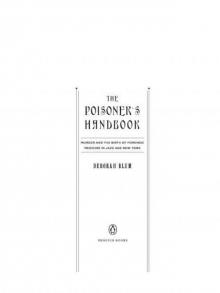 The Poisoner's Handbook
The Poisoner's Handbook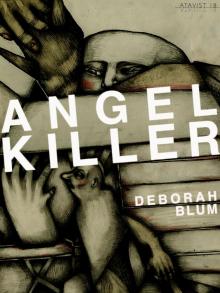 Angel Killer
Angel Killer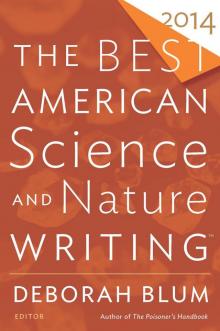 The Best American Science and Nature Writing 2014
The Best American Science and Nature Writing 2014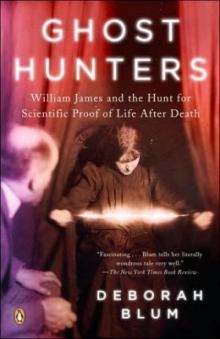 The Ghost Hunters
The Ghost Hunters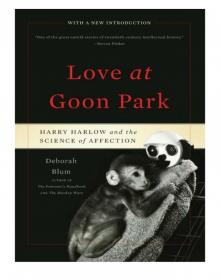 Love at Goon Park
Love at Goon Park